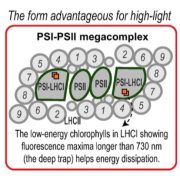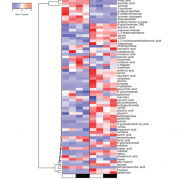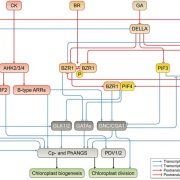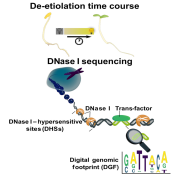Photochemistry beyond the red limit in chlorophyll f–containing photosystems ($) (Science)
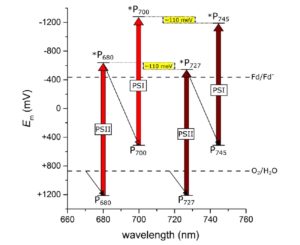 Plant scientists are familiar with the steep drop in photosynthetic activity when plants are illuminated with far-red photons (> 700 nm), because the energy of these long-wavelength photos is insufficient to initiate photochemistry at the chlorophyll a reaction center. Previously, some studies have indicated that the long-wavelength chlorophyll f can serve as an antenna complex pigment, by using heat energy to augment the energy of the longer-wavelength photons so that they can be transferred effectively to the chlorophyll a reaction center. Nürnberg et al. have now shown that chlorophyll f can in fact initiate photochemistry itself in long-wavelength light. The authors grew Chroococcidiopsis thermalis (a type of cyanobacteria) in long-wavelength light (750 nm), which led to a shift their light absorbing properties and their photosynthetic action spectra. Through studies at very low temperatures, the authors demonstrated that the chl f itself, without employing a thermal boost, can initiate photochemistry. Thus, this study provides evidence that the 700 nm photosynthetic limit is breached. (Be sure to also read the Supplementary Materials for this paper, which are excellent and provide additional analysis, interpretation and discussion). (Summary by Mary Williams) Science 10.1126/science.aar8313
Plant scientists are familiar with the steep drop in photosynthetic activity when plants are illuminated with far-red photons (> 700 nm), because the energy of these long-wavelength photos is insufficient to initiate photochemistry at the chlorophyll a reaction center. Previously, some studies have indicated that the long-wavelength chlorophyll f can serve as an antenna complex pigment, by using heat energy to augment the energy of the longer-wavelength photons so that they can be transferred effectively to the chlorophyll a reaction center. Nürnberg et al. have now shown that chlorophyll f can in fact initiate photochemistry itself in long-wavelength light. The authors grew Chroococcidiopsis thermalis (a type of cyanobacteria) in long-wavelength light (750 nm), which led to a shift their light absorbing properties and their photosynthetic action spectra. Through studies at very low temperatures, the authors demonstrated that the chl f itself, without employing a thermal boost, can initiate photochemistry. Thus, this study provides evidence that the 700 nm photosynthetic limit is breached. (Be sure to also read the Supplementary Materials for this paper, which are excellent and provide additional analysis, interpretation and discussion). (Summary by Mary Williams) Science 10.1126/science.aar8313


